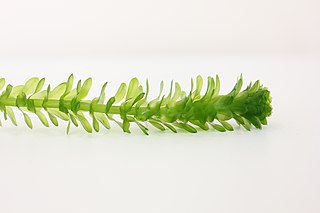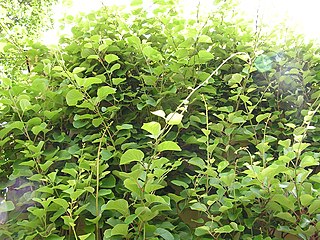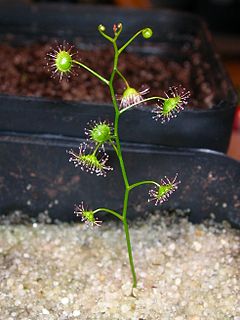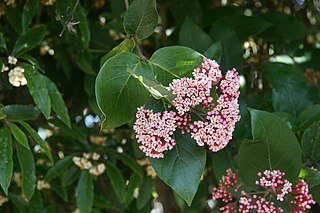| Purdiaea | |
|---|---|
 | |
| Purdiaea cubensis var. cubensis | |
| Scientific classification | |
| Kingdom: | Plantae |
| Clade: | Angiosperms |
| Clade: | Eudicots |
| Clade: | Asterids |
| Order: | Ericales |
| Family: | Clethraceae |
| Genus: | Purdiaea Planch. |
Purdiaea is a genus of flowering plants in the family Clethraceae described as a genus in 1846. [1] [2] [3] It is one of two genera in this family, and was formerly classified in the related family Cyrillaceae. Purdiaea is native to tropical regions of the Caribbean (with the highest species diversity on Cuba), Central America and northern South America, further south than the related genus Clethra , the only other genus of this family.
A genus is a taxonomic rank used in the biological classification of living and fossil organisms, as well as viruses, in biology. In the hierarchy of biological classification, genus comes above species and below family. In binomial nomenclature, the genus name forms the first part of the binomial species name for each species within the genus.

The flowering plants, also known as angiosperms, Angiospermae or Magnoliophyta, are the most diverse group of land plants, with 64 orders, 416 families, approximately 13,164 known genera and c. 369,000 known species. Like gymnosperms, angiosperms are seed-producing plants. However, they are distinguished from gymnosperms by characteristics including flowers, endosperm within the seeds, and the production of fruits that contain the seeds. Etymologically, angiosperm means a plant that produces seeds within an enclosure; in other words, a fruiting plant. The term comes from the Greek words angeion and sperma ("seed").
Family is one of the eight major hierarchical taxonomic ranks in Linnaean taxonomy; it is classified between order and genus. A family may be divided into subfamilies, which are intermediate ranks between the ranks of family and genus. The official family names are Latin in origin; however, popular names are often used: for example, walnut trees and hickory trees belong to the family Juglandaceae, but that family is commonly referred to as being the "walnut family".
The genus is composed of shrubs and small trees with alternating leaves.

A shrub or bush is a small- to medium-sized woody plant. Unlike herbaceous plants, shrubs have persistent woody stems above the ground. They are distinguished from trees by their multiple stems and shorter height, and are usually under 6 m (20 ft) tall. Plants of many species may grow either into shrubs or trees, depending on their growing conditions. Small, low shrubs, generally less than 2 m (6.6 ft) tall, such as lavender, periwinkle and most small garden varieties of rose, are often termed "subshrubs".

In botany, a tree is a perennial plant with an elongated stem, or trunk, supporting branches and leaves in most species. In some usages, the definition of a tree may be narrower, including only woody plants with secondary growth, plants that are usable as lumber or plants above a specified height. Trees are not a taxonomic group but include a variety of plant species that have independently evolved a woody trunk and branches as a way to tower above other plants to compete for sunlight. Trees tend to be long-lived, some reaching several thousand years old. In wider definitions, the taller palms, tree ferns, bananas, and bamboos are also trees. Trees have been in existence for 370 million years. It is estimated that there are just over 3 trillion mature trees in the world.
- Selected species
- Purdiaea belizensis (A.C.Sm. & Standl.) J.L.Thomas – "Belize purdiaea," Central America.
- Purdiaea cubensis (A.Rich.) Urb. – "Cuban purdiaea," "Clavellina," SE USA, Cuba.
- Purdiaea ekmanii Vict. – Cuba
- Purdiaea microphylla Britton & P.Wilson – Cuba
- Purdiaea nipensis Vict. & León – Cuba
- Purdiaea nutans G.Planch. – Venezuela, Ecuador, Peru
- Purdiaea ophiticola Vict. – Cuba
- Purdiaea shaferi Britton – Cuba
- Purdiaea stenopetala Griseb. – Cuba
- Purdiaea tereosepala J.L.Thomas – Cuba
- Purdiaea velutina Britton & P.Wilson – Cuba

Brother Marie-Victorin, F.S.C., was a Canadian member of Brothers of the Christian Schools and a noted botanist in Quebec, Canada. He is known as the father of the Botanical Garden of Montreal.

Nathaniel Lord Britton was an American botanist and taxonomist who co-founded the New York Botanical Garden in the Bronx, New York.














